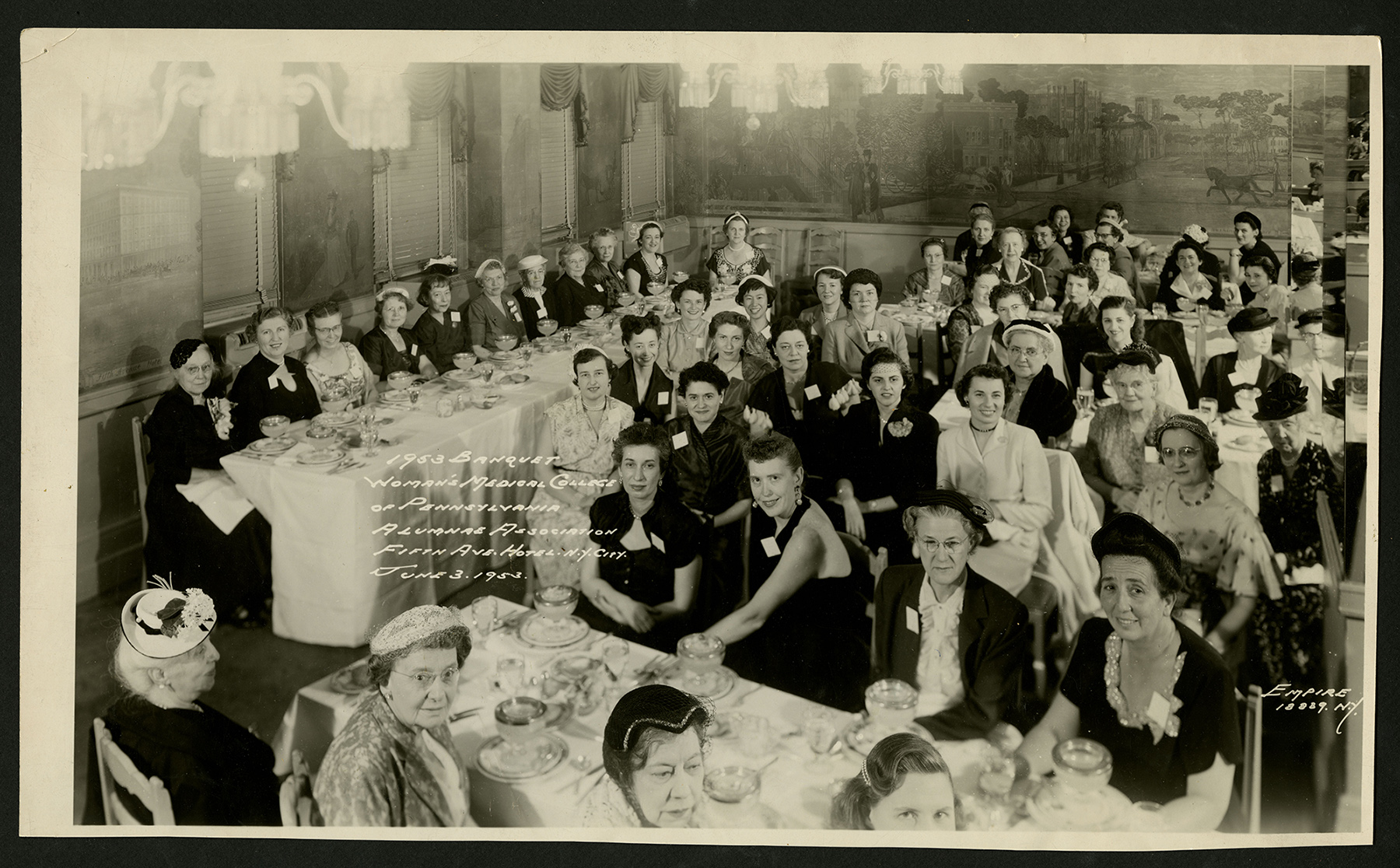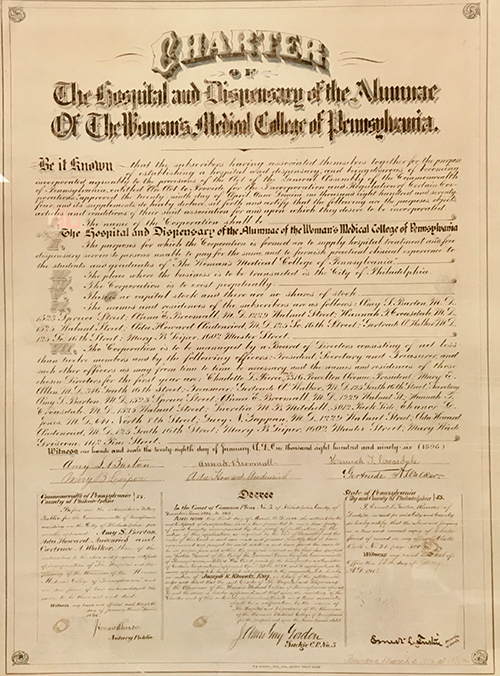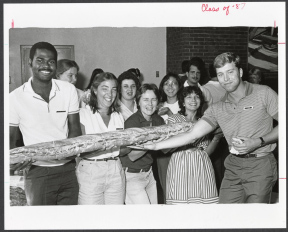A Long Story Shortened: The Alumni Association History Information Project
By G. K. Schatzman
THE DEVELOPMENT OF THE ALUMNI ASSOCIATION HISTORY INFORMATION PROJECT
THE IDEA
Histories rarely have just one beginning. For Claudia S. Plottel, MD, MCP ’84, Alumni Association board member and immediate association past-president, the idea came during a conversation with fellow board member Tim Manzone, JD, MD, MCP ’89.
“Tim mentioned to me how he and Ellie [Ellie Cantor, PhD pharmacology, MCP ’79], both also Alumni Association past presidents, kept going back to the fact that someone should be compiling the history of DUCOM legacy medical colleges’ Alumni Associations,” Plottel recounts.
Manzone adds, “The roots of our Alumni Association stretch back nearly 150 years, originating from two separate institutions that merged during difficult times. We knew and felt fortunate that we had considerable archival information, and it was important to review and preserve this information for current and future alumni.”
For Cantor, the idea of documenting the associations’ legacy began to form years ago during a time of crisis for the university, when she found herself drawn back to her alma mater. “PhD alums tend not to see the Alumni Association in the same way as a group of med students who spent four years together as a cohort,” Cantor explains. “We’re much more attuned to our laboratory or our departments.” To remedy that, the board had reached out to Cantor in 1997 to offer her an award and then invited her to join the board of the new combined Alumni Association of MCP Hahnemann University. At one of her first meetings, the news was announced: “The university has gone bankrupt.”
During the ensuing crisis years, leading up to Drexel’s eventual incorporation of the school, members of the Alumni Association went all-hands-on-deck to manage alumni affairs in the absence of internal staffing support or funding. “We were the lifeboats,” says Cantor. “You know when they have to cross a river in the military, and there’s no bridge, and they have to use those floating pontoons? That’s what we were. We all did everything. It was just a lot of hard-working people who cared.”
Today, Cantor says, that dedication to serving students and preserving experiences for future classes is still a foundational part of the board’s organizational culture, even as new members cycle in. “Over the years, we have told this story over and over again. Those of us who lived through the bankruptcy, the restructuring and the Drexel merger have worked very hard to keep this history alive.” It was a mission, she says, that Manzone shared.

Alumni Associations organized reunions, homecomings and other celebratory events like this 1953 WMC alumnae banquet, to bring students and graduates together.
“This is an exciting opportunity to formulate a unified historical narrative of the Alumni Associations, which have always served as the best link to the schools’ legacies, histories and graduates,” Manzone says.
Something clicked for Plottel as she heard Manzone and Cantor’s ideas. Thinking back to a recent article from Drexel News1, featuring photos and documentation from The Legacy Center archives, on the role of Woman’s Medical College in combatting the 1918 flu pandemic, she saw a cornucopia of primary source materials that could help them systematically explore and document the history and the reach of the Alumni Associations of the legacy schools at the College of Medicine. “I said, ‘If there are such precise records of the annual meetings from a hundred years ago, there must be more really good stuff to know about.’”
They agreed: The associations’ 145-year history — the roles they played in dire times and the values that carried them through — should be explored honored, and preserved. “Instead of a couple of us informally digging through what papers Ellie and Tim might have, we decided we should develop a more formal project,” Plottel says.
April 2021 brought the official beginning of the Alumni Association History Information Project (AAHIP for the syllable conscious, pronounced “ah-hip”). Plottel presented the concept at the meeting of the Alumni Association Board of Directors, to a favorable response. Then, Plottel and Alumni Relations staff members Nikki Bromberg and Jennifer Carolina-Bell had a series of meetings with Legacy Center archives staff members Margaret Graham and Matthew Herbison.

Charter of the Hospital and Dispensary of the Alumnae of the Woman’s Medical College of Pennsylvania, 1896. In 1905, the dispensary was renamed The Amy S. Barton Dispensary after its founder.
“Everyone who we discussed the proposed project with was extremely enthusiastic, which made us all think that we were on to something,” Plottel recalls. At its September 2021 meeting, the board voted to formally fund the AAHIP project, thanks to the Kate Campbell Hurd-Mead ’88 Fund. “The idea was to create a project that would explore and document the history and the reach of the Alumni Associations of the legacy schools at the College of Medicine. We thought that this would be a very novel initiative and that The Legacy Center would be the perfect partner for the project.”
THE PROJECT
To lead the project, The Legacy Center’s director, Margaret Graham, brought on Theana Noelle Kastens, an archivist teaching art history at George Mason University and Northern Virginia Community College. As it happens, Kastens is also something of a detective, a cornerstone quality when piecing together decades of never-told history.
Thanks to institutional records and donations from innumerable alums and their kin, The Legacy Center archives hold troves of documents, photographs, newspapers, rare books, textiles, audiovisual media, medical instruments, artwork, furniture and ephemera. Some boxes arrive neatly organized. Others are hastily packed by grieving family members with the countless little memories of their loved one’s life. The Legacy Center takes everything that fits within their collection policy2, because everything tells a story.
Unearthing the history of the Alumni Associations at Hahnemann and Woman’s Medical meant surveying 60 archival collections from institutional records and personal papers. “Laid end-to-end, it all came out to about 150 linear feet. To give you perspective, that’s one and a half blue whales,” Kastens says. Within that large body of artifacts run countless connections great and fine, crisscrossing the corpus like strands of nerve and tendon, that Kastens carefully mapped.
“Our office looked like a scene from A Beautiful Mind where Russel Crowe is hanging things up on the walls,” she says. The stories emerged, and with the help of Suzanne Dreitlein, web manager for the College of Medicine, who turned Kastens’ vision into an online exhibit, and Bromberg, who kept the project rolling forward, the stories took shape.
THE EXHIBIT AND BEYOND

Class of 1987 at Freshman Welcome in 1983, sponsored by the Alumni Association.
Exhortations to young women physicians abroad during the first World War. Efforts to preserve the study of homeopathic medicine in the United States. Powerful moments of collective action in the face of sexism throughout the decades. Summer retreats on Long Lake, Maine. “It became my mission to shed light on those voices and stories that hadn’t been shared for so long,” Kastens says.
The new exhibit creates paths to explore these narratives and plenty beyond, the tip of the iceberg when it comes to the history of the Alumni Associations. “Whenever I’d come across materials that weren’t directly related to activities, I had to pry myself away because I’d be so captivated,” Kastens says. “Off the top of my head, I see two screenplays that could be written based off these stories. I just get lost in it.”
Not all of the stories are complete, of course; the location of the White Pines summer camp in the ’50s, for instance, remains a mystery to Kastens. “There are gaps in the history,” she says, “but because of the survey we know what those gaps are.” The special thing about these mysteries is that they are all solvable. Every missing link lies in someone’s memory, in an old photo or a letter waiting, patiently, in an attic box beneath a blanket of dust. Perhaps you yourself have the missing end or forgotten beginning of an old story, though you might not know it until it finds its fellows. When the gang gets back together, all sorts of rusty tales turn up.
Time and again, the stories and historical records confirm what has long attracted alums like Cantor, Manzone and Plottel to the association: values of dedication, continuity and service driving graduates to give back to the school that helped shape their professional paths. In a way, looking back through the history of the Alumni Associations is like looking in a mirror. As Cantor says, “We’re standing on the shoulders of people whose legacy we can carry forward.”
Notes:
1. Falcone, A. “In Their Own Words: The Front Lines of the 1918 Influenza Pandemic.” Drexel News, September 24, 2020: drexel.edu/news/archive/2020/september/in-their-own-words-the-1918-influenza-pandemic
2. Those interested in donating items to the Legacy Center archives should email com_archives@drexel.edu or call 215.991.8340.
Back to Top